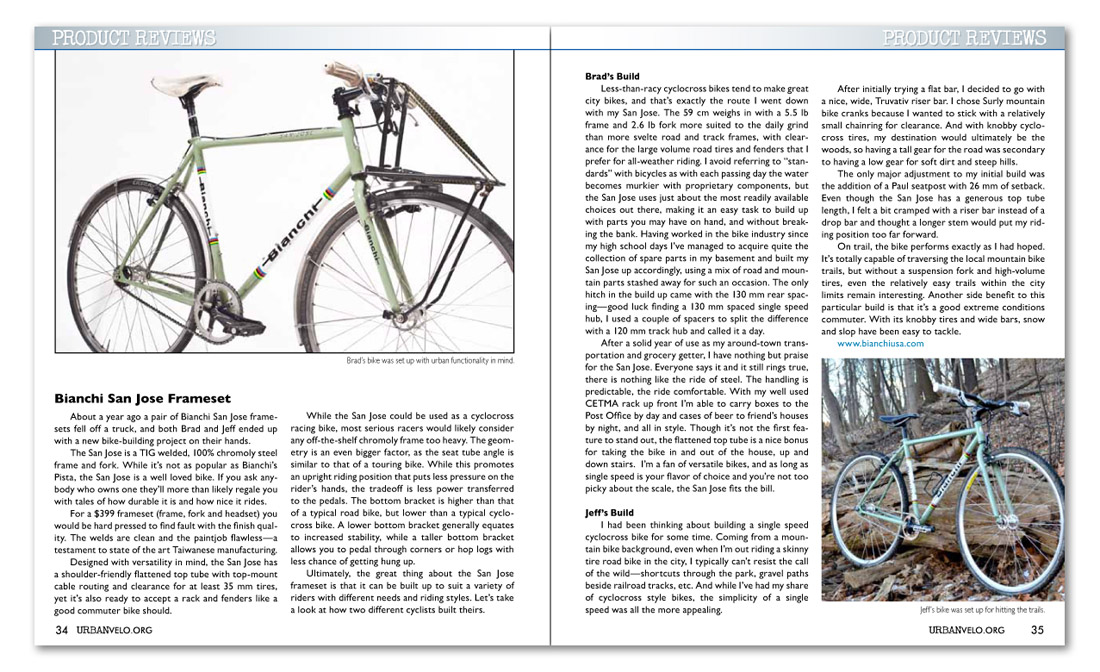


Bianchi San Jose Frameset
About a year ago a pair of Bianchi San Jose framesets fell off a truck, and both Brad and Jeff ended up with a new bike-building project on their hands.
The San Jose is a TIG welded, 100% chromoly steel frame and fork. While it’s not as popular as Bianchi’s Pista, the San Jose is a well loved bike. If you ask anybody who owns one they’ll more than likely regale you with tales of how durable it is and how nice it rides.
For a $399 frameset (frame, fork and headset) you would be hard pressed to find fault with the finish quality. The welds are clean and the paintjob flawless—a testament to state of the art Taiwanese manufacturing.
Designed with versatility in mind, the San Jose has a shoulder-friendly flattened top tube with top-mount cable routing and clearance for at least 35 mm tires, yet it’s also ready to accept a rack and fenders like a good commuter bike should.
While the San Jose could be used as a cyclocross racing bike, most serious racers would likely consider any off-the-shelf chromoly frame too heavy. The geometry is an even bigger factor, as the seat tube angle is similar to that of a touring bike. While this promotes an upright riding position that puts less pressure on the rider’s hands, the tradeoff is less power transferred to the pedals. The bottom bracket is higher than that of a typical road bike, but lower than a typical cyclocross bike. A lower bottom bracket generally equates to increased stability, while a taller bottom bracket allows you to pedal through corners or hop logs with less chance of getting hung up.
Ultimately, the great thing about the San Jose frameset is that it can be built up to suit a variety of riders with different needs and riding styles. Let’s take a look at how two different cyclists built theirs.
Brad’s Build
Less-than-racy cyclocross bikes tend to make great city bikes, and that’s exactly the route I went down with my San Jose. The 59 cm weighs in with a 5.5 lb frame and 2.6 lb fork more suited to the daily grind than more svelte road and track frames, with clearance for the large volume road tires and fenders that I prefer for all-weather riding. I avoid referring to “standards” with bicycles as with each passing day the water becomes murkier with proprietary components, but the San Jose uses just about the most readily available choices out there, making it an easy task to build up with parts you may have on hand, and without breaking the bank. Having worked in the bike industry since my high school days I’ve managed to acquire quite the collection of spare parts in my basement and built my San Jose up accordingly, using a mix of road and mountain parts stashed away for such an occasion. The only hitch in the build up came with the 130 mm rear spacing—good luck finding a 130 mm spaced single speed hub, I used a couple of spacers to split the difference with a 120 mm track hub and called it a day.
After a solid year of use as my around-town transportation and grocery getter, I have nothing but praise for the San Jose. Everyone says it and it still rings true, there is nothing like the ride of steel. The handling is predictable, the ride comfortable. With my well used CETMA rack up front I’m able to carry boxes to the Post Office by day and cases of beer to friend’s houses by night, and all in style. Though it’s not the first feature to stand out, the flattened top tube is a nice bonus for taking the bike in and out of the house, up and down stairs. I’m a fan of versatile bikes, and as long as single speed is your flavor of choice and you’re not too picky about the scale, the San Jose fits the bill.
Jeff’s Build
I had been thinking about building a single speed cyclocross bike for some time. Coming from a mountain bike background, even when I’m out riding a skinny tire road bike in the city, I typically can’t resist the call of the wild—shortcuts through the park, gravel paths beside railroad tracks, etc. And while I’ve had my share of cyclocross style bikes, the simplicity of a single speed was all the more appealing.
After initially trying a flat bar, I decided to go with a nice, wide, Truvativ riser bar. I chose Surly mountain bike cranks because I wanted to stick with a relatively small chainring for clearance. And with knobby cyclocross tires, my destination would ultimately be the woods, so having a tall gear for the road was secondary to having a low gear for soft dirt and steep hills.
The only major adjustment to my initial build was the addition of a Paul seatpost with 26 mm of setback. Even though the San Jose has a generous top tube length, I felt a bit cramped with a riser bar instead of a drop bar and thought a longer stem would put my riding position too far forward.
On trail, the bike performs exactly as I had hoped. It’s totally capable of traversing the local mountain bike trails, but without a suspension fork and high-volume tires, even the relatively easy trails within the city limits remain interesting. Another side benefit to this particular build is that it’s a good extreme conditions commuter. With its knobby tires and wide bars, snow and slop have been easy to tackle.